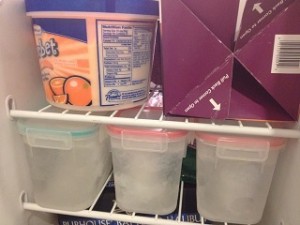
How many containers of frozen water would fit in your freezer?
This well-known quote comes from “The Rime of the Ancient Mariner,” written in the mid-1700s by Samuel Taylor Coleridge. His poem tells of a ship becalmed whose crew dies of thirst. In a big storm or other emergency, we are not likely to find ourselves in the middle of a salt-water ocean, but we certainly could find ourselves facing serious thirst with only questionable or clearly dirty water available. So once again, I want to address the issue of where to find drinking water. By now you know that you can live for days without food, but not long at all without water.
Here are four more ideas for where to find water in an emergency:
1. Buy and store water that comes in regular commercial containers. You can buy water in all-sized bottles, cans, and foil packets. Store as much as you can, and refresh regularly. Avoid storing water in plastic directly on cement. According to the LA County Dept. of Public Health, cement can pass through the container into the water.
2. Capture water from alternate sources.
- Your water heater holds 40-80 gallons, and if you have kept it reasonably clean by regularly draining off silt and calcium build-up at the bottom, it can be a life-saver.
- The toilet tank (not the bowl) can be another source of water, it you haven’t used chemicals or colors in it.
- A swimming or decorative garden pool might give you water for washing or even flushing the toilet. Don’t drink it without treating it first. (See below, number 4.)
3. Still more ideas for storing water.
- Freeze water in clean plastic containers and fill in spaces in the freezer, as shown in the photo. Ice will keep your freezer cooler, save energy – and provide a source of clean water as the freezer defrosts in a power outage. Don’t use plastic that has had milk or meat products in it. And leave space at the top of the container for the water to expand. (I take mine out once in a while and dump the ice in a flower bed, then refresh the water supply.)
- Buy large storage containers that fit the space you have available. If you can put a barrel outside, get a 55-gallon drum with spigot. If you don’t have that option, consider “WaterBricks.” An 8-pack of these 3+ gallon blue plastic containers stack and connect for compact storage of 28 gallons. (Lying flat, they might fit perfectly under a bed.)
4. Don’t forget agents to turn dirty water into drinkable water!
- The LifeStraw is a personal water filter that would allow you to drink from a puddle or stream. Simple, light, easy to store, filters over 250 gallons of suspect water. Get one for every person, and every survival kit, particularly your car kit.
- Water treatment tablets or drops are widely available. They take about 30 minutes to purify contaminated water. Be sure to follow instructions exactly.
Let us know YOUR good ideas for storing water for emergencies. Just drop them into the comment box to share!
Virginia
Your Emergency Plan Guide Team
Subscribe below so you don’t miss any of these good ideas. One of them could save your life!
Don't miss a single Advisory.
Thank you for subscribing.
Something went wrong.
